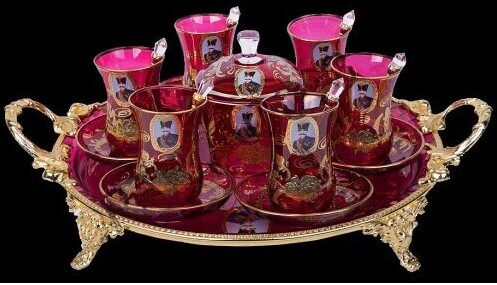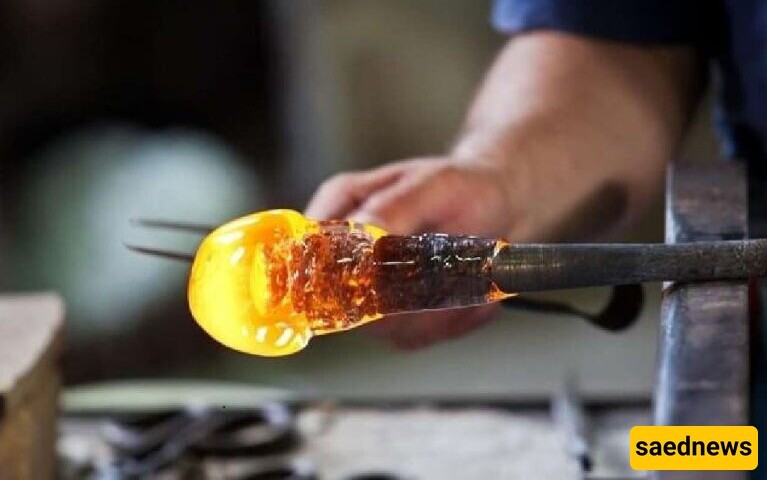Saednews: Glassmaking or "Abgineh" is one of the oldest arts in the world. In this article, we will explore the history, methods, tools, and productions of glassmaking.

According to the Family Magazine Service of Saednews, glassmaking or "Abgineh" is one of the oldest arts in the world. Glassmaking is one of the most popular arts throughout history, dating back to around 2000 BC. This craft requires special tools and specific skills. For a period of time, the traditional methods of glassmaking were overlooked after the Industrial Revolution, but gradually it regained its place in the modern world. In this article, we will explore the history, methods, tools, and products of glassmaking.
The oldest glass pieces found around the Euphrates River indicate the ancient people’s attention to this art. With the spread of this art worldwide and innovations in production methods, some major cities became hubs of this industry. Among these cities are:
Venice
Alexandria
Damascus
On the other hand, archaeological evidence indicates the development of this art in Iran. A Greek play from before Christ, written by Aristophanes, mentions crystal cups in Persepolis. Additionally, a 2250-year-old necklace with blue glass beads from northern Iran and green glass fragments from prehistoric times found in Lorestan and Susa are some of the evidence of the growth and spread of this industry in Iran.
Despite the long history of glassmaking in the world, there are various methods for production in glassmaking. In fact, each of these methods has advantages over the others and also allows for the creation of diverse types of glass. Below, we will introduce the two main methods of this industry.
The art of glassmaking through blowing is the technique of breathing air into glass. This process is done after the main glassmaking steps, such as melting silica. This method itself has two sub-methods, which are the free-blown method and the blown-molded method. Let's review the characteristics of these two methods:
Free-Blown Method: In this method, after melting the silica attached to the blowpipe, the glassmaker blows into it, creating a bubble inside the glass. The shape is then modified using other tools and further blowing.
Blown-Molded Method: In this method, after melting the glass, it is placed along with the blowpipe into a mold. Blowing air into the glass shapes it according to the mold.

Another method of glassmaking is the pressed glass technique. In this method, after melting the silica, the glassmaker places it into a press mold and removes it from the blowpipe. Air pressure is applied to the mold, shaping the glass according to the desired form.
Tools Used in Glassmaking
Just like in all other arts, specific tools are used in glassmaking. These tools must be resistant to high temperatures. Typically, they are made of metal or wood. Here are some of the tools used:
Blowpipe: A hollow metal tube into which molten glass is placed. The glassmaker blows air through this pipe into the molten glass. It is also used for movement in glassmaking, such as in the pressed method.
Tongs: Similar to common tongs, this tool is used in glassmaking to shape the glass.
Spoon: A tool used for shaping. The spoon is made from a wooden cylinder that helps even out the thickness of the glass. It is important to note that the spoon is kept wet during use in glassmaking.
Razor: Similar to a kitchen knife, but with greater resistance. It is used to cut or score the separation area of the glass.
Scissors: Another tool resembling regular scissors, used in glassmaking to cut off excess glass and separate parts, just like a razor.
Board: This tool, made of wood, like other wooden tools in glassmaking, must be kept wet continuously. The board is used for shaping the corners and the overall form of glass objects, and it comes in various sizes.
Board Mold: Made of wood and kept wet, the board mold consists of two wooden boards. Its purpose is to control and shape the glass objects.
Coloring Glass
Colored glass has been one of the most important products of glassmaking throughout history. To color glass, metal oxide powders are used. These oxides must be thoroughly mixed with the molten base glass. Here are some of the metal oxides and the colors they produce in glassmaking:
Green Color: A combination of iron powder and bichromate produces this color.
Blue Color: Cobalt oxide is used to create a deep blue color in glassmaking.
Red Color: Selenium or copper oxide creates this beautiful red color in glass.
Purple: Purple has been one of the unique glass colors from the past to the present, created by adding a combination of manganese oxide and cobalt to the glass.
Brown: To create brown glass, pyrite, sulfur, and charcoal are used.
Productions of Glassmaking
Glassmaking includes a wide range of products. Some of the products made in glassmaking are:
Blow glass
Double and triple-layered glass
Water glass
Matte glass
Decorative glass
Glass combined with metal
Carved glass

Glassmaking Art: Timeless Beauty
Glassmaking is an art with a long history. Over time, it has become one of the most popular forms of handicrafts. It is believed that the origin of this art is in Egypt, but major hubs of this craft, such as Venice and Damascus, have left behind beautiful creations. In this article, we discussed various methods of production and the tools needed to create glassworks.

